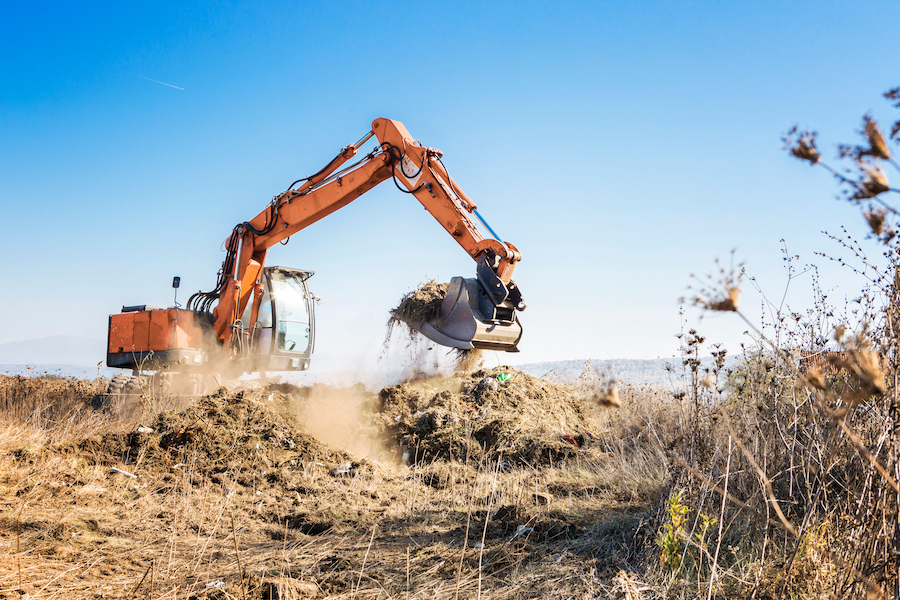
View the complete article here.
Clearing land might be something that anybody with the right equipment can pull off… but the question is—can they do it efficiently and affordably? Because if you’re a contractor who handles big projects on a frequent basis then it’s crucial that you aren’t spending too much money and time on this task.
1. Assess the Land and Plan Ahead
Start by evaluating the land you will be working on to determine the scope of the project. Look for potential obstacles such as rocks, trees, and slopes. Proper planning helps to minimize surprises and avoid costly mistakes during the land clearing process. Create a detailed plan outlining the objectives, timeline, and the equipment needed for the job.
2. Choose the Right Equipment
Selecting the appropriate equipment is crucial for completing the project efficiently and affordably. The most common machinery used for land clearing includes:
- Bulldozers: Ideal for pushing large debris and leveling the ground.
- Excavators: Useful for digging and removing tree stumps, rocks, and other obstacles.
- Skid steer loaders: Versatile machines that can be fitted with various attachments for grading, digging, and removing debris.
- Chippers and grinders: For processing and recycling cleared vegetation.
If your budget is tight, consider renting equipment instead of purchasing it to save on costs—especially if you don’t plan on using it frequently.
3. Clear Vegetation and Debris
Start by removing all vegetation—including trees, shrubs, and bushes. Use chainsaws to cut down trees and a chipper or grinder to break down the vegetation into mulch, which can be recycled or sold. Remember to wear proper safety gear when using chainsaws and other heavy machinery.

4. Remove Tree Stumps and Rocks
Tree stumps and rocks can hinder construction and need to be removed. Use excavators or stump grinders to remove stumps—while heavy-duty machines like bulldozers can help in removing large rocks. For smaller rocks, skid steer loaders with grapple attachments can be highly efficient.
5. Level and Grade the Land
Once the land is clear of vegetation, stumps, and rocks—use a bulldozer or skid steer loader with a grading attachment to level the land. Proper grading is essential for drainage and preventing erosion.
6. Manage Soil Erosion and Sedimentation
During the land clearing process, soil erosion can be a significant concern. Implement erosion control measures such as silt fences, sediment ponds, and temporary seeding of exposed soil. Properly managing erosion will save you time and money in the long run.
7. Dispose of Waste Responsibly
It’s essential to dispose of waste materials responsibly to minimize the environmental impact. Recycle or sell cleared vegetation and use the appropriate facilities to dispose of other waste. Proper waste management helps to minimize costs and maintain a good reputation in the industry.
Conclusion
Clearing land efficiently and affordably requires careful planning, selecting the right equipment, and following best practices. By adhering to these guidelines, contractors and heavy equipment operators can successfully clear land while minimizing costs and environmental impact.
View the complete article here.
How can land be cleared efficiently and affordably?
Efficient and affordable land clearing involves several steps. Firstly, plan and understand the scope of work, including any specific requirements like preserving certain trees or structures. Utilize suitable machinery like bulldozers, excavators, or forestry mulchers, which can handle the tasks more efficiently. Hiring professionals can be cost-effective in terms of safety and efficiency. Also, consider the disposal of waste material which can be done through burning, hauling away, or recycling.
What factors can influence the cost of land clearing?
Several factors can influence the cost of land clearing. These include the size and type of land, the density of vegetation, the terrain, the presence of structures or trees to be preserved, the disposal method for the waste material, and whether you're doing it yourself or hiring professionals. Having a clear plan and understanding these factors can help manage costs more effectively.













































